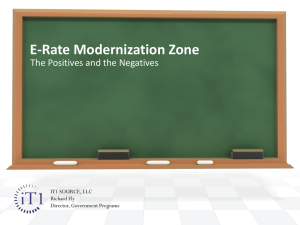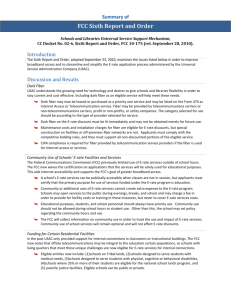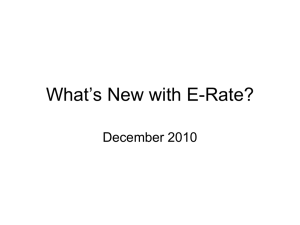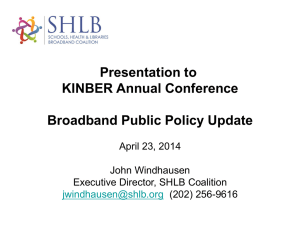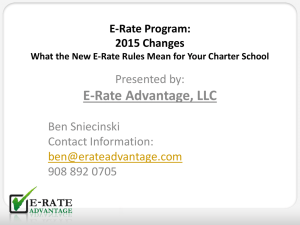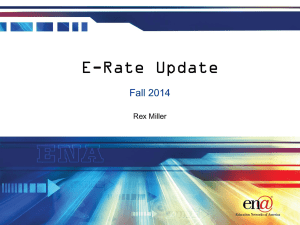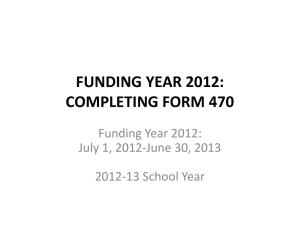E-Rate Checklist - Massachusetts Department of Education
advertisement
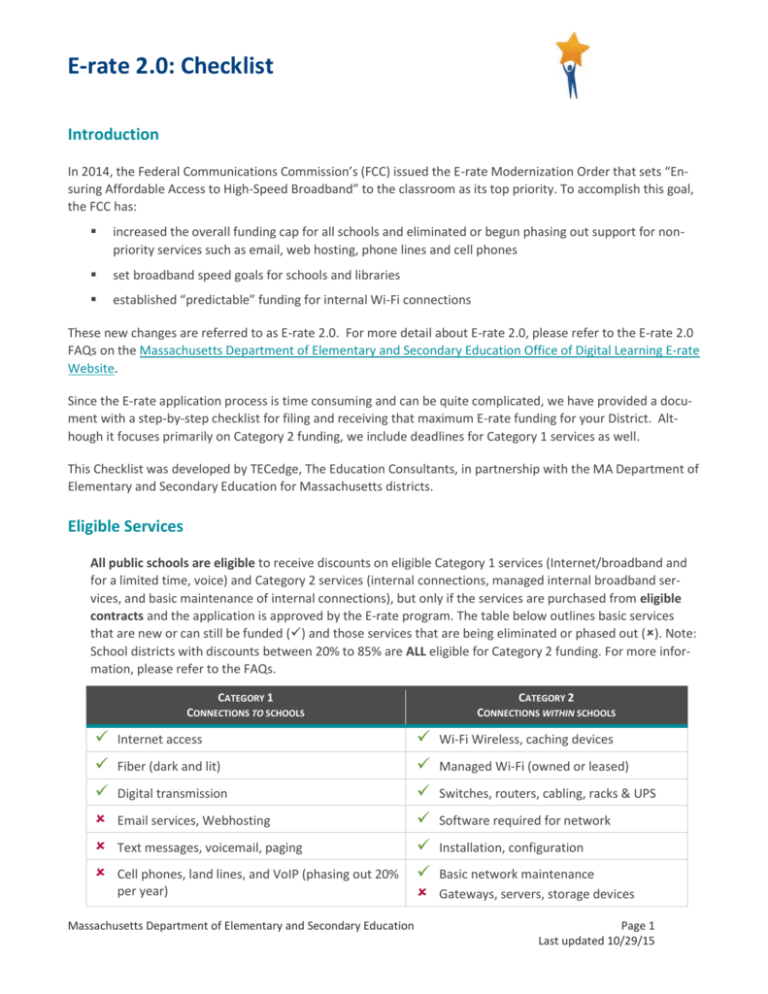
E-rate 2.0: Checklist Introduction In 2014, the Federal Communications Commission’s (FCC) issued the E-rate Modernization Order that sets “Ensuring Affordable Access to High-Speed Broadband” to the classroom as its top priority. To accomplish this goal, the FCC has: increased the overall funding cap for all schools and eliminated or begun phasing out support for nonpriority services such as email, web hosting, phone lines and cell phones set broadband speed goals for schools and libraries established “predictable” funding for internal Wi-Fi connections These new changes are referred to as E-rate 2.0. For more detail about E-rate 2.0, please refer to the E-rate 2.0 FAQs on the Massachusetts Department of Elementary and Secondary Education Office of Digital Learning E-rate Website. Since the E-rate application process is time consuming and can be quite complicated, we have provided a document with a step-by-step checklist for filing and receiving that maximum E-rate funding for your District. Although it focuses primarily on Category 2 funding, we include deadlines for Category 1 services as well. This Checklist was developed by TECedge, The Education Consultants, in partnership with the MA Department of Elementary and Secondary Education for Massachusetts districts. Eligible Services All public schools are eligible to receive discounts on eligible Category 1 services (Internet/broadband and for a limited time, voice) and Category 2 services (internal connections, managed internal broadband services, and basic maintenance of internal connections), but only if the services are purchased from eligible contracts and the application is approved by the E-rate program. The table below outlines basic services that are new or can still be funded () and those services that are being eliminated or phased out (). Note: School districts with discounts between 20% to 85% are ALL eligible for Category 2 funding. For more information, please refer to the FAQs. CATEGORY 1 CONNECTIONS TO SCHOOLS CATEGORY 2 CONNECTIONS WITHIN SCHOOLS Internet access Wi-Fi Wireless, caching devices Fiber (dark and lit) Managed Wi-Fi (owned or leased) Digital transmission Switches, routers, cabling, racks & UPS Email services, Webhosting Software required for network Text messages, voicemail, paging Installation, configuration Cell phones, land lines, and VoIP (phasing out 20% per year) Basic network maintenance Gateways, servers, storage devices Massachusetts Department of Elementary and Secondary Education Page 1 Last updated 10/29/15 E-rate Process The following graphic provides an overview of the E-rate process. Approximate E-rate Timeline The following graphic illustrates the timeline for major E-rate events. Since one E-rate year takes almost two years to prepare and complete, districts typically are dealing with three applications during any one fiscal year, as shown below. Massachusetts Department of Elementary and Secondary Education Page 2 E-rate Filing Checklist STEP 1. HARD DEADLINE TIMELINE ACTIVITY YOUR STATUS September If your district decides not to use CEP to calculate students through eligible for free and reduced lunch, work with schools to November maximize the number of students eligible for Free and Reduced Meals. Try to maximize students eligible for free and reduced meals using techniques such as family applications, direct certification, and sibling matching. Use the counts reported to ESE through the food service reimbursement claims website, since food service is the system of record for NSLP data. The new rules require the E-rate discount to be calculated for the entire district rather than for individual schools. In the past, schools in the same district could have different discount rates based on each school’s percentage of students eligible for free and reduced meals. Now all schools in the district have the same district discount. Massachusetts Department of Elementary and Secondary Education Page 3 STEP 2. HARD DEADLINE TIMELINE 4. YOUR STATUS Submit Invoices for services provided in the previous funding year before October 28 for Category 1 unless you have requested and received permission for an extension. Use the FCC Form 472 Billed Entity Applicant Reimbursement (BEAR) to submit invoices if you have paid for the services in full and want to be reimbursed for the discount amount. You can file BEAR forms online or on paper. This is referred to as Invoicing Method Number 1 at the USAC E-rate Website http://www.universalservice.org/sl/serviceproviders/step05/default.aspx . Method Number 2 is for the vendor to receive the discount if they have reduced your bill by the discount amount. They submit the FCC Form 474, Service Provider Invoice (SPI) Form http://www.universalservice.org/sl/serviceproviders/step05/default.aspx . You may request and automatically receive a single one-time 120-day extension of the deadline to submit an invoice for the FCC Form 472 (BEAR Form) or FCC Form 474 (SPI Form). Invoice deadline extension requests must be submitted to USAC on or before the invoice deadline in order for the request to be considered timely filed. Otherwise a waiver must be sought from the FCC. If missed the filing deadline and you have submitted an extension request, you must wait until it is approved before submitting the BEAR Form. 10/28 Category 1 1/28 Category 2 Unless extension requested 3. ACTIVITY For FRNs with Funding Commitment Decision Letters (FCDLs) dated or before July 1, the Form 486s that certify the start of service must be submitted by October 29. For FRNs approved after July 1, the Form 486 deadline is 120 days from the FCDL approval date or the start of service date, whichever is later. October 29 Fall Watch for the FCC to announce the deadline for filing the Erate application (Form 471). This deadline is set in the fall each year by the FCC and is subject to change. Other dates are relative to this date. In recent years this deadline has been in March to apply for E-rate for the following fiscal year. Massachusetts Department of Elementary and Secondary Education Page 4 STEP 5. 6. HARD DEADLINE TIMELINE ACTIVITY Late Fall Identify E-rate service needs in the coming year. Use ESE’s E-rate Estimator Tool to determine your district’s Category 2 E-rate reimbursement at http://www.doe.mass.edu/odl/grants/e-rate.html The reimbursement is based on the following formula: all schools a budget of $150 per student for Wi-Fi over a 5-year period (4 years remaining). Use the Bandwidth Calculator http://www.tecedge.net/ErateBandwidthCalculator.htm to determine if your district needs more bandwidth. This calculator is based on the SETDA recommended bandwidth requirements. Inventory the classrooms and other critical spaces in your schools to determine whether or not you need increased Wi-Fi or increased bandwidth. Put together a plan for increasing bandwidth and installing and/or replacing Wi-Fi over the next four years. Remember, even if you put Wi-Fi in recently, in several years you may need new access points. Work with your business office, academic departments, and school committee to identify matching funds and develop a strategy for the elimination of subsidies for phone, cell phones, web hosting, email, and voicemail. Work with the school committee and town/city to identify the additional local funds needed. If you cannot identify enough local funds to add/expand Wi-Fi in all the schools, remember you do not have to spend your budget all in one year. If limited local funds are available: implement over several years or consider Managed Wi-Fi, which minimizes a onetime cost through leasing. At least December 28 Days through Before February Form 471 is due YOUR STATUS Form 470, the notice that you are seeking services, must be filed no later than 28 days before the Form 471 application is due, although it is recommended that it be filed earlier. Note that recently the Form 471 application has been due in March. All eligible contracts must result from a competitive bid that starts with the filing of the Form 470 that describes the services needed. Think of it as advertising in the Goods and Services Bulletin, except that Massachusetts Department of Elementary and Secondary Education Page 5 STEP HARD DEADLINE TIMELINE ACTIVITY YOUR STATUS E-rate requires the posting of a Form 470 for all services regardless of dollar amount. Tariff or month-to-month services such as basic telephone service or Internet access may not require a contract, but they still require a Form 470. If you receive services under a contract, the contract with the vendor must be signed and dated before the submission of the district’s Form 471 application. If you post a Form 470 and sign a multi-year contract resulting from that posting, you do not have to post an FCC Form 470 or open a competitive bidding process again for the life of that contract. The only exception to the Form 470 and competitive bidding requirement is for commercially available Internet service that does not exceed $3,600 per year per school and whose speed is at least 100 Mbps downstream and 10 Mbps upstream. NOTE: refer to the FAQs for more detail about how bids must be conducted and awarded. Use a state contract to simplify the process. Several state contracts with E-rate eligible items have already posted a Form 470 and are an eligible contract under E-rate. (Refer to FAQs for rules for purchasing off a state contract). The major contracts are: ITT46 - Telecommunication Network Services ITC47 - Information Technology Hardware, Project Management, Integration, and Maintenance. Note that Category 6 (Project Management, Maintenance, Integration, Incidental Hardware, Goods and Services from other Statewide Contracts) includes a "one-stop shopping" provision. ITC50 - Converged Voice and Data Communications Systems, Services and Equipment ITC54 - Data Cable Products and Services Retain that all documents used to prepare the application as well as invoices for discounted services be kept for at least 10 years after the last day of service delivered. Refer to FAQs for a list of required Massachusetts Department of Elementary and Secondary Education Page 6 STEP HARD DEADLINE TIMELINE ACTIVITY YOUR STATUS documents. 7. 1/28 for Category 2 Services 8. TBD Invoices for Category 2 services provided in the previous funding year must be submitted by January 28 unless you have requested and received permission for an extension. Please refer to Step 1 for more information about filing reimbursement claims and invoice extensions. Usually March File and Certify Form 471 to request services for Category 1 and Category 2 for the next fiscal year. 9. April Review the Receipt Notification Letter (RAL) for each application and submit corrections if necessary. Corrections can be made on certain fields until the Funding Commitment Decision Letter (FCDL), but the sooner the better. 10. May through possibly October Respond to all Program Integrity Assurance (PIA) questions within 15 calendar days. USAC tries to complete all reviews by July 1, but often reviews are not complete until afterwards. It is not unusual for Category 2 requests to still be under review long after July. 11. May through possibly November Review the Funding Commitment Decision Letter (FCDL). If you do not agree with the FCDL, you may appeal to USAC if you believe USAC did not correctly apply the FCC rules. If USAC followed the FCC rules but feel extenuating circumstances should have been taken into account, you can seek a waiver from the FCC. 12. July 1 File the Form 486, indicating the start of services, if you have received the FCDL and services have begun on July 1. Otherwise file the Form 486 no later than 120 days after the funding commitment decision letter or the service start date, whichever is later. 13. 14. File FCC Form 500 Adjustment to Funding Commitment and Modification to Receipt of Service Confirmation if necessary to reduce the funding commitment amount or modify the beginning or ending date for services received. 10 years Keep track of all the equipment installed. The E-rate program requires asset tracking of equipment purchased with E-rate funds. Should USAC’s on-site auditors arrive, they may ask to see the installed equipment. Refer to FAQs for more detail about these requirements. Massachusetts Department of Elementary and Secondary Education Page 7

